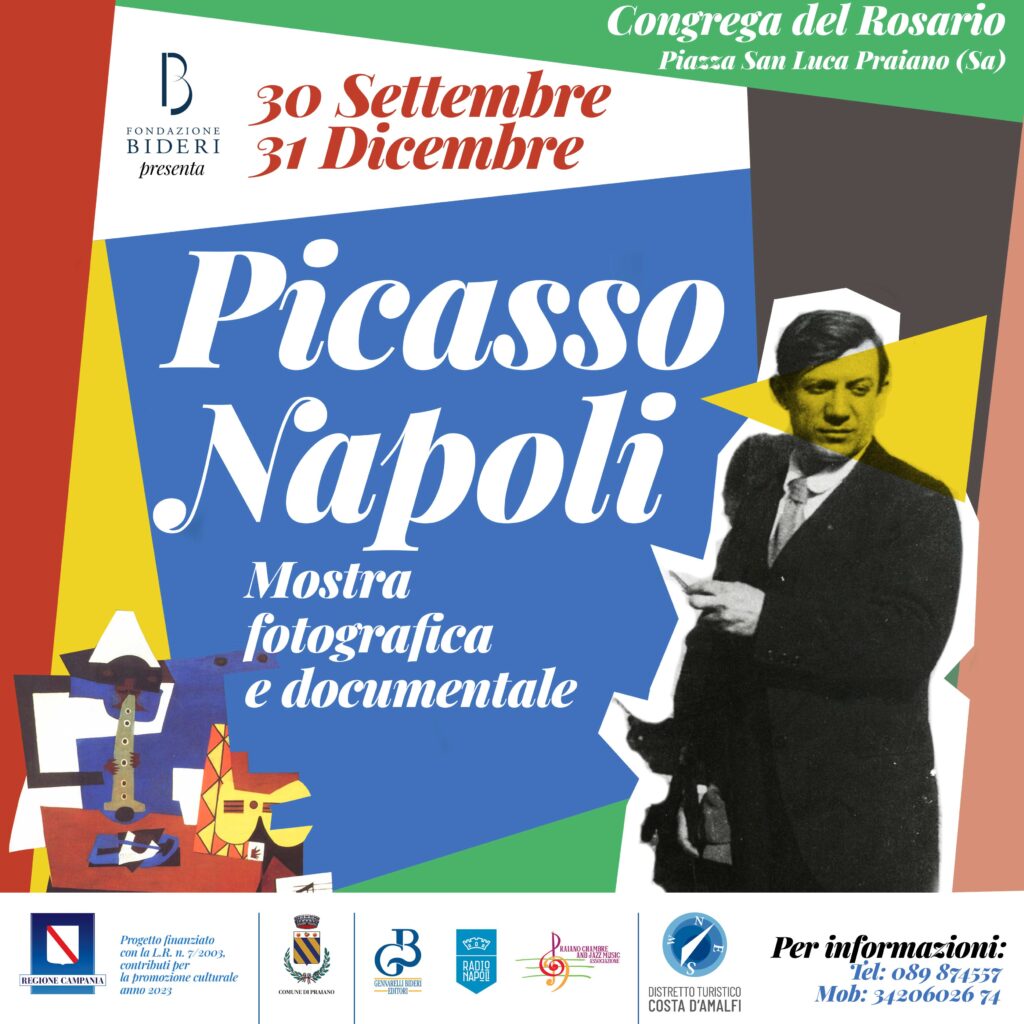
PANEL 1 – THE DOUBLE NEAPOLITAN STAY
Pablo Picasso arrived in Italy, in Rome, in February 1917 together with Jean Cocteau: the Russian impresario Sergei Diaghilev invited them to involve them in the staging of the ballet Parade.
If Cocteau had to take care of the opera’s libretto, Picasso had to design the ‘rideau de scene’, the large curtain that hung above the stage.
The two arrive in Naples on March 9th for a holiday period wanted by Diaghilev. Together with them there are also Leonardo Massine, choreographer of Parade, and Igor Stravinsky, author of the music.
It is Picasso’s first Neapolitan stay, who is staying at the Grand Hotel Vesuvio until March 13th. Before leaving for Rome he makes an epiphanic excursion to Pompeii with part of the group and with the futurist Francesco Cangiullo, who probably acts as his guide in Naples.
Picasso returns to the city on April 15th following the Ballets Russes company, engaged at the San Carlo. Visit Pompeii again and then Positano and Capri. On 21 April he sent an enthusiastic postcard to Cocteau: the text was enriched by a drawing by Olga Khokhlova, the company’s étoile who would become his first wife.
PANEL 2 – NAPLES IN THE EYES OF PICASSO
Room 114 of the Grand Hotel Vesuvio gives Picasso a view of the seaside village of Castel dell’Ovo. He is so enchanted by it that he fixes it on the graphed paper of his notebook.
In those days of March, and then in those of April, he sets out to discover a sunny and dramatic city: an “Arab Montmartre”, according to Cocteau, who portrays its vertical dimension in the Siloca drawing.
In Picasso’s eyes, images of the streets renewed by the post-cholera sanitation of 1884 alternate with those of urban spaces unchanged over time and in the popular traditions that mark everyday life.
With Cocteau he explored the Spanish Quarter and the alleys of the port area, with Stravinsky he visited the Maritime Zoological Station several times, attracted by the frescoes in the library created by Hans von Marées.
Two other visits then filled him with suggestions and creative stimuli: the one to the National Archaeological Museum and the one to the San Martino Museum.
PANEL 3 – PICASSO AND NEAPOLITAN SONGS
“My dear Jean, we are writing to you from the restaurant where we had lunch with the Russian consuls. We are happy and sing Neapolitan songs”: this can be read in the postcard that Picasso sent to Cocteau on 21 April 1917.
His interest in Neapolitan popular culture therefore crosses one of its most identifying and defined forms.
What songs does Picasso listen to during that lunch? It is impossible to answer this question: there are no documents that help identify them.
One can only imagine that, probably, the musicians present in the restaurant (parking attendants?) perform the main hits of the 1910s and some great classics.
Picasso certainly doesn’t listen to Reginella, a song composed, yes, in 1917 but published in September.
PANEL 4 – THE MAIN NEAPOLITAN SONGS OF THE 1910S
1910
Sora mia!, R. Galdieri – E. De Curtis
Surdate, L. Bovio – E. Nardella
1911
Ah! L’ammore che ffa fa’!, E. Murolo – E. De Curtis
Comme se canta a Napule, E.A. Mario
Core ‘ngrato, R. Cordiferro – S. Cardillo
E bonasera ammore, R. Galdieri – E. Nardella
I’ m’arricordo ‘e te (Lucia Luci), G.B. De Curtis – E. De Curtis
Niny Tirabusciò, A. Califano – S. Gambardella
Quanno tramonta ‘o sole, E. Russo – S. Gambardella
1912
‘A canzone ‘e Napule, L. Bovio – E. De Curtis
‘A marina ‘e Tripoli, G. Capaldo
Funtana all’ombra, E.A. Mario
Na vota sola!, R. Galdieri – E. Nardella
Te si’ scurdate ‘e Napule, E. Murolo – E. Nardella
1913
Autunno, L. Bovio – E. De Curtis
‘E palumme, O. Gallo – M. Persico
lo, na chitarra e ‘a luna, E.A. Mario
Maggio si’ tu!, E.A. Mario
Nun voglio fa’ niente (Està), L. Bovio – N. Valente
Sona chitarra, L. Bovio – E. De Curtis
Tarantella luciana, L. Bovio – E. Cannio
1914
Guapparia, L. Bovio – R. Falvo
‘O mare ‘e Margellina, A. Califano – R. Falvo
Tammurriata all’antica, E. Murolo – E.A. Mario
Tammurriata palazzola, F. Russo – R. Falvo
1915
Napule canta, L. Bovio – E. Tagliaferri
‘O surdato nnammurato, A. Califano – E. Cannio
Tu ca nun chiagne, L. Bovio – E. De Curtis
Mandulinata a mare, A. Califano – F. Buongiovanni
1916
‘A serenata ‘e Pulicenella, L. Bovio – E. Cannio
Il bel Ciccillo, A. Trusiano – G. Capaldo
Pupatella, L. Bovio – E. Buongiovanni
Tiempe belle, A. Califano – V. Valente
1917
Nun so’ geluso, A. Gill
‘O guappo nnammurato, R. Viviani
Popolo po’, E. Murolo – V. Di Chiara
Reginella, L. Bovio – G. Lama
‘O zampugnaro ‘nnammurato, A. Gill (published in 1924)
PANEL 5 – NEAPOLITAN WAR SONGS
In Picasso’s memoirs there are no echoes of the First World War.
It is not excluded, however, that during lunch with the Russian consuls he would listen to one of the many Neapolitan songs inspired by the First World War: for example, ‘O surdato nnamurato, published two years earlier.
The hypothesis is based on the consistency of the corpus of Neapolitan war songs and its notable diffusion in that period.
A repertoire as vast as it is varied in its treatment of the theme, which began to take shape before 1915/18. The numerous songs composed during the Italian-Turkish conflict of 1911, fueled by the colonial dream of conquering Libya, bear witness to this.
Speaking of ‘O surdato nnamurato, a curiosity should be noted: the one written by Aniello Califano and Enrico Cannio is not the only song with this title, there is another composed by Luigi Fragna.
PANEL 6 – SINGING TO THE INFANTS, SOSPIRARING MARIE
In the first months of our war, I noted the successes of our army and proclaimed: “The mandolin therefore does not enter into our war score”.
Today I repent and confess: “Yes, even the mandolin participates in the belligerent orchestra”. The mandolin, the guitar, the calascione… yes, in short, the traditional instruments that accompany the extended voice of Naples, in whose harmonious spirit every feeling of the people has a lyrical translation, every gesture is profiled in the rhythm of music.
Newspaper correspondents from the front described to us the soldier of Italy – and more specifically that of southern Italy – in the throes of an intoxication with song and poetry. And not only during the hours of rest: we have been told that our infantryman goes into the assault singing.
The song is, therefore, a documented energy of war. So, welcome to the war score. From the rear to the trenches, let her speak her language of love, of hope, of faith, let her be a messenger of comfort and creator of prowess, let her shed tears if she later hovers over the assault.
Saverio Procida War Piedigrotta, Piedigrotta Gennarelli 1918
PANEL 7 – NEAPOLITAN INFLUENCES IN THE PARADE CURTAIN
Picasso began creating the curtain for Parade during the first week of May 1917, a few days after his Neapolitan stay.
The Neapolitan suggestions are still vivid in his mind and re-emerge, here and there, in the compositional dictate he is defining: especially in relation to the group of actors, on the right of the curtain, gathered around a table in a moment of pause.
Many scholars agree on this hypothesis, if anything they are divided on the works seen in Naples by Picasso that inspire. There are two opposing theses.
The first refers to the frequent visits made with Stravinsky to the Anton Dohrn aquarium, where they appreciated the paintings of Hans von Marées. In particular, it is believed that Picasso painted the convivial of the curtain recalling that which characterizes the scene of the Pergola, a fresco present in the library of the Neapolitan zoological station.
The second thesis, however, believes that the iconographic reference to be considered is a popular scene. To be precise, the one portrayed in Taverna, an aquatint by Achille Vianelli, which Picasso would have seen at the San Martino Museum together with other similar works by the painter of the Posillipo School.
Although divergent, both theses identify the representation of food and its sharing at the table as a key element of the curtain of Parade. A typical element of Neapolitan culture.
PANEL 8 – PULCINELLA AND PICASSO
The ballet Pulcinella was performed at the Paris Opéra on 15 May 1920, with music by Stravinsky, choreography by Massine and sets and costumes by Picasso.
On the stage of the greatest French theater the atmospheres of the Neapolitan alleys and markets, the charm of ancient Pompeii and the great tradition of Italian commedia dell’arte come to life.
The planning of the work began during the Neapolitan stays of 1917, once again with input from Sergei Diaghilev.
In 1963 Massine precisely retraces those days during a 1963 interview granted as a witness to that experience.
He remembers the walks to Sanità and Forcella and the searches for Pulcinella which took them around the city among second-hand shops and libraries and then on to a visit to the National Museum of San Martino.
There, in fact, there is a precious collection of memories of the Neapolitan theater and, above all, a life-size model of the stage of the San Carlino Theater with wax figures in costume: it is an opportunity to see Pulcinella in a real theater after having met him many times in improvised scenes on the street.
The visit to the National Museum of San Martino is decisive for Picasso’s subsequent works: the scenography he creates for Pulcinella combines the chromaticism and realism of the iconographic sources consulted with the geometric approach of cubism.
PANEL 9 – PICASSO BETWEEN POMPEII AND POSITANO
At the end of his second Neapolitan stay, Picasso and the working group set up by Diaghilev left for a trip to the Amalfi coast. After a new stop in Pompeii and a quick trip to Capri, the varied company spends a few days in Positano.
Upon seeing the picturesque Positano houses clinging to the rock, Diaghilev exclaims: “But this is truly an extraordinary example, indeed unique in the world, of a vertical village!”. Lèonide Massine, on the other hand, is attracted by the three islands of the Gauls, of the largest he says that “it has the dramatic power and mystery of a painting by Salvator Rosa”.
Picasso is little interested in scenic beauties, preferring the female ones who participate in the dinners in honor of the group. One of these takes place on April 25th at the Fornillo tower. It was organized by the Swiss archaeologist Gilbert Clavel, who renovated that tower to make it his home, transforming a ruin into a cultural cenacle.
A few days later Picasso and the others returned to Naples to leave permanently on 28 April.
In his book Last Journeys in Lost Italy Raffaele La Capria writes:
“Whoever wants to explain what culture was in Naples in the first half of the 20th century must not overlook this coming and going of visitors who arrived after those of the Grand Tour, because, albeit in confused and indirect ways, they kept open a relationship between culture Neapolitan culture and the major currents of European culture and art of this century”.
